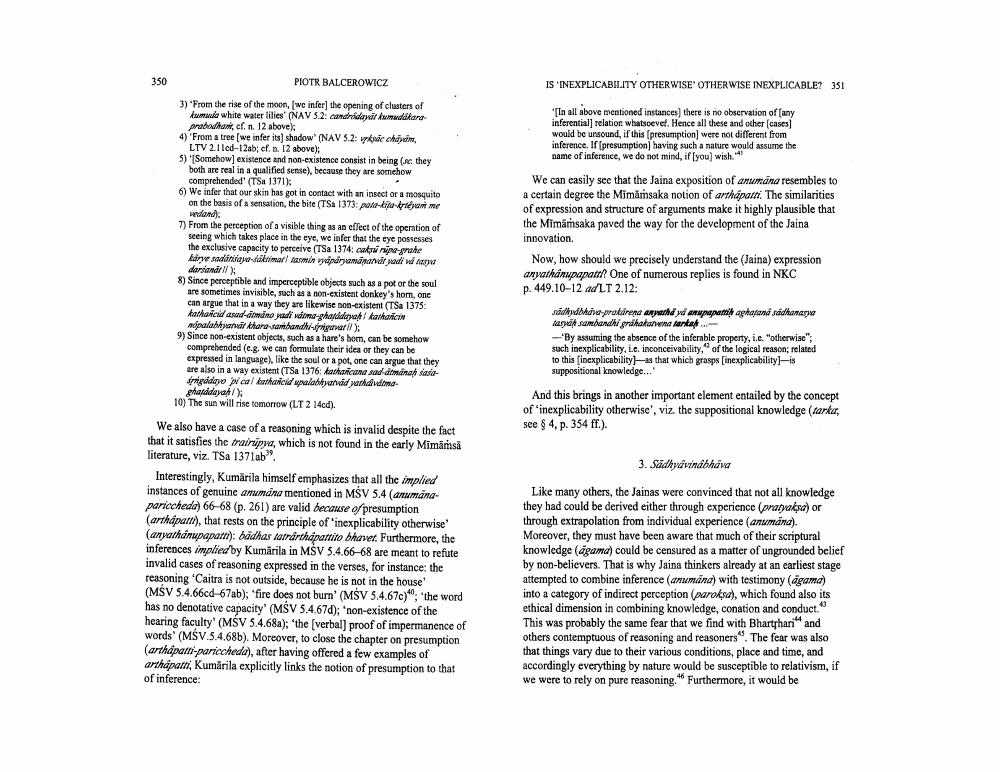Book Title: Is Inexplicability Otherwise Otherwise Inexplicable Author(s): Piotr Balcerowicz Publisher: Piotr Balcerowicz View full book textPage 5
________________ 350 PIOTR BALCEROWICZ IS INEXPLICABILITY OTHERWISE' OTHERWISE INEXPLICABLE? 351 "[In all above mentioned instances, there is no observation of (any inferential] relation whatsoevet. Hence all these and other cases would be unsound, if this (presumption) were not different from inference. If (presumption) having such a nature would assume the name of inference, we do not mind, if you wish. 3) From the rise of the moon, (we infer] the opening of clusters of kumuule white waterlilies' (NAV 5.2: candrea m ana prodan, ef. n. 12 above): 4) From a tree (we inferits) shadow' (NAV 5.2: take cje, LTV 2.1 led-12ab; cf. n. 12 bove) 5) (Somehow] existence and non-existence consist in being they both are real in a qualified sense), because they are somehow comprehended' (TSa 1371): 6) We infer that our skin has got in contact with an insect or a mosquito on the basis of a sensation, the bite (TSa 1373: p r eme verland) 7) From the perception of a visible thing as an effect of the operation of seeing which takes place in the eye, we infer that the eye possesses the exclusive capacity to perceive (TSa 1374 anti -grate dre damarlesmi dari pada darslanirl); 8) Since perceptible and imperceptible objects such as a pot or the soul are sometimes invisible, such as a non-existent donkey's hom, one can argue that in a way they are likewise non-existent (TSa 1375: Rarriate -indu s hailaiyai namள nepala dan mandh a ril); 9) Since non-existent objects, such as a hare's hom, can be somehow comprehended (eg. we can formulate their idea or they can be expressed in language), like the soul or a pot, one can argue that they are also in a way existent (TSa 1376: danhancang sad dominat sasistrigodose catalana alatidura de halddayah/); 10) The sun will rise tomorrow (LT 2 14cd). We can casily see that the Jaina exposition of anumana resembles to a certain degree the Mimamsaka notion of arthapath. The similarities of expression and structure of arguments make it highly plausible that the Mimarisaka paved the way for the development of the Jaina innovation. Now, how should we precisely understand the (Jaina) expression anyathanupapat? One of numerous replies is found in NKC p. 449.10-12 ad LT 2.12: sady do pratirena ar dari handdonare fasad sambandhi grataren fantap.... -By assuming the absence of the inferable property, i.e. "otherwise"; such inexplicability, i.c. inconceivability," of the logical reason; related to this inexplicability!-as that which grasp [inexplicability)-15 suppositional knowledge...! And this brings in another important element entailed by the concept of 'inexplicability otherwise', viz. the suppositional knowledge (tarka, see $ 4, p. 354 ff.). We also have a case of a reasoning which is invalid despite the fact that it satisfies the trainipya, which is not found in the early Mimarisă literature, viz. TSa 1371ab" 3. Sadhavinábhava Interestingly, Kumirila himself emphasizes that all the implied instances of genuine animana mentioned in MSV 5.4 (anumana pariccheda) 66 68 (p. 261) are valid because of presumption (arthapan), that rests on the principle of 'inexplicability otherwise (anwaridupapandi): bidhas tatrárthapartito bhaver. Furthermore, the inferences implied by Kumarila in MSV 5.4.66-68 are meant to refute invalid cases of reasoning expressed in the verses, for instance: the reasoning 'Caitra is not outside, because he is not in the house (MSV 5.4.66cd-67ab); 'fire does not burn' (MÁV 5.4.67c)"; "the word has no denotative capacity' (MSV 5.4.67d); 'non-existence of the hearing faculty' (MSV 5.4.68a); "the (verbal) proof of impermanence of words' (MSV 5.4.68b). Moreover, to close the chapter on presumption (arta particchada), after having offered a few examples of artha Kumarila explicitly links the notion of presumption to that of inference: Like many others, the Jainas were convinced that not all knowledge they had could be derived either through experience (prahu ) or through extrapolation from individual experience anumana) Moreover, they must have been aware that much of their scriptural knowledge (agama) could be censured as a matter of ungrounded belief by non-believers. That is why Jaina thinkers already at an earliest stage attempted to combine inference (animand) with testimony (agama) into a category of indirect perception (paroksa), which found also its ethical dimension in combining knowledge, conation and conduct. This was probably the same fear that we find with Bharthanand others contemptuous of reasoning and reasoners. The fear was also that things vary due to their various conditions, place and time, and accordingly everything by nature would be susceptible to relativism, if we were to rely on pure reasoning. Furthermore, it would bePage Navigation
1 ... 3 4 5 6 7 8 9 10 11 12 13 14 15 16 17 18 19 20
